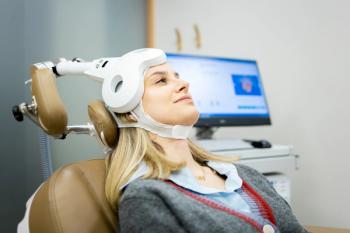
- Vol 41, Issue 3
Augmentation Strategies for Treatment-Resistant Depression
Given that two-thirds of patients treated for a major depressive episode will fail to achieve remission of symptoms after 2 or more treatment trials of first-line antidepressants, the probability of remission will further decrease with subsequent medication trials. Treatment strategies for patients with TRD include augmentation, where a medication is added to a current antidepressant versus switching to a different antidepressant.
SPECIAL REPORT: TREATMENT-RESISTANT DEPRESSION
Many patients presenting with unipolar major depression do not achieve remission after their initial treatment. The term treatment-resistant depression (TRD) typically refers to major depression that does not remit after 2 antidepressant trials of adequate dose and duration; however, the definition has not been standardized.1,2
Several staging models have been proposed over the years for classifying and defining TRD. The Thase and Rush Model is the most widely used in TRD. In this model, failure to respond to 1 adequate antidepressant trial from a major antidepressant class is considered stage I TRD, and those who then do not respond to a second adequate antidepressant trial (from a different class than the antidepressant used in stage I) are termed stage II TRD.3 Several guidelines or staging methods outline specific requirements (eg, the number of adequate trials, dosage, duration, and types of agents) that must be met prior to the patient’s diagnosis as treatment resistant. These methods vary in the degrees of resistance described.4 Other staging methods include the European Staging Model, the Massachusetts General Hospital Staging Model, and the Maudsley Staging Model.5 The overarching staging criteria propose a higher degree of treatment resistance with more treatment failures.
Across different studies of patients with unipolar
Augmentation Strategies
Given that two-thirds of patients treated for a major depressive episode will fail to achieve remission of symptoms after 2 or more treatment trials of first-line antidepressants,9 the probability of remission will further decrease with subsequent medication trials.10 Treatment strategies for patients with TRD include augmentation, where a medication is added to a current antidepressant versus switching to a different antidepressant.
Augmentation strategies can improve treatment response in those who have had a partial response to an initial antidepressant trial. Several clinical trials have examined the relative effectiveness of augmentation of existing antidepressants versus switching to antidepressant monotherapy.11-13 The STAR*D trial revealed that bupropion augmentation and switching to monotherapy were as effective as other treatment strategies.11 The Veterans Affairs Augmentation and Switching Treatment for Improving Depression Outcomes (VAST-D) trial (NCT01421342) showed that augmentation with either aripiprazole or bupropion was more effective than switching to monotherapy with bupropion.12 Similarly, the Optimizing Outcomes of Treatment-Resistant Depression in Older Adults (OPTIMUM) study (NCT02960763) showed that augmentation with aripiprazole was significantly more effective than switching to bupropion monotherapy in achieving remission of depressive symptoms in older adults with TRD.13
The selection of an augmenting agent may depend on patients’ depressive symptoms and clinical presentation. Bupropion is a norepinephrine and dopamine reuptake inhibitor commonly used as monotherapy and adjunct therapy in TRD, but may lower seizure threshold.14 In patients endorsing
Augmentation with second-generation antipsychotics has also exhibited efficacy in the treatment of TRD, thought to be mediated through dopamine receptors.17 Aripiprazole, brexpiprazole, and quetiapine have been approved by the US Food and Drug Administration (FDA) for adjunctive therapy in treating depression. Aripiprazole augmentation has been studied in older adults and was more effective than placebo.18 To illustrate further, a pooled analysis of 16 randomized trials compared adjunctive aripiprazole, olanzapine, quetiapine, or risperidone with placebo in 3480 patients with nonpsychotic, unipolar major depression who failed at least 1 course of antidepressant monotherapy and showed that remission occurred in more patients who received an adjunctive antipsychotic compared with placebo (31% versus 17%, respectively).19
Role of Psychotherapy
Another alternative is to switch from pharmacotherapy to psychotherapy (eg,
Neuromodulation and Interventionals
Electroconvulsive Therapy
Electroconvulsive therapy (ECT) has been used for the past 80 years and has robust evidence for TRD treatment, displaying a 64% response rate and 48% remission rate in individuals with TRD. ECT is superior to pharmacotherapy for treating depression23 and is associated with reduced psychiatric hospital readmissions.24 Despite its high efficacy rate, ECT’s use has been limited due to its previous negative depictions in popular culture and the associated negative connotation.
ECT is generally safe, yet it is associated with adverse events such as headaches, muscle aches, and cognitive adverse effects. Anterograde amnesia and memory loss can be associated with ECT; however, they resolve within a few weeks of finishing an ECT course, and cognitive function is further improved from baseline thereafter.25 Additionally, these cognitive adverse effects last longer in older adults or when using bitemporal electrode placement. Further advancements in ECT techniques have led to improvements over the years and decreased ECT-related adverse events, including cognitive outcomes and improving patient experience.
Repetitive Transcranial Magnetic Stimulation
Large controlled trials led to FDA approval of
In patients with TRD, rTMS stimulation of the left dorsolateral prefrontal cortex has resulted in significant improvement of depressive symptoms.26 In addition, rTMS is used as an adjunct treatment to pharmacotherapy and was shown to increase the likelihood of response and remission of symptoms. The durability of rTMS has been exhibited at 12 months’ follow-up after acute treatment.27 A meta-analysis of 4 randomized trials (213 patients) compared high-frequency repetitive TMS plus antidepressants (primarily selective serotonin reuptake inhibitors) with antidepressants alone as initial treatment and found that remission occurred more often with combination treatment (odds ratio, 2.4; 95% CI, 1.3-4.6).28
TMS has several advantages: It does not require general anesthesia and has no cognitive adverse effects due to its focal administration. This is particularly important for older adults with TRD, as it has a benign cognitive profile compared with ECT.
Ketamine
Ketamine is an anesthetic agent with N-methyl- D-aspartate receptor (NMDAR) blockade properties that has more recently been shown to be a promising and novel augmentation agent for the treatment of depression. Multiple studies have confirmed the efficacy of intravenous ketamine for TRD.29 Intravenous (IV) ketamine is given at subanesthetic doses of 0.5 mg/kg over a 40-minute infusion, typically 2 or 3 times a week over 3 to 4 weeks. Esketamine, the intranasal form, received FDA approval in 2019 for treatment of depression. Although IV ketamine appears to be more efficacious than esketamine,30 it is rarely covered by insurance and costs are covered by patients out of pocket. To further support ketamine, a recent open-label, randomized, noninferiority trial (NCT03113968) compared treatment response in 403 participants with TRD who received IV ketamine or ECT.31 The results of this study found IV ketamine to be noninferior to ECT based on the primary outcome being response to treatment, which was defined as a greater than 50% reduction in score on the Quick Inventory of Depressive Symptomology scale. Furthermore, the participants in the IV ketamine arm had fewer cognitive adverse effects and decline in memory recall compared with the ECT group.
Dr Madan is an assistant professor in the Department of Psychiatry at the University of Arizona College of Medicine in Tucson. Dr Oughli is an assistant professor in the Department of Psychiatry and Biobehavioral Sciences at the University of California, Los Angeles. Dr Gebara is an assistant professor in the Department of Psychiatry at the University of Pittsburgh School of Medicine in Pennsylvania.
References
1. Berlim MT, Turecki G.
2. Fekadu A, Donocik JG, Cleare AJ.
3. Thase ME, Rush AJ.
4. Souery D, Papakostas GI, Trivedi MH.
5. Trevino K, McClintock SM, McDonald Fischer N, et al.
6. Trivedi MH, Rush AJ, Wisniewski SR, et al; STAR*D Study Team.
7. Fava M, Davidson KG.
8. Zhdanava M, Pilon D, Ghelerter I, et al.
9. Rush AJ, Trivedi MH, Wisniewski SR, et al.
10. Buchalter ELF, Oughli HA, Lenze EJ, et al.
11. Rush AJ, Trivedi MH, Wisniewski SR, et al; STAR*D Study Team.
12. Mohamed S, Johnson GR, Chen P, et al.
13. Lenze EJ, Mulsant BH, Roose SP, et al.
14. Tran K, McGill SC, Horton J.
15. de Boer T.
16. Bauer M, Adli M, Bschor T, et al.
17. Ostroff RB, Nelson JC.
18. Lenze EJ, Mulsant BH, Blumberger DM, et al.
19. Nelson JC, Papakostas GI.
20. Ijaz S, Davies P, Williams CJ, et al.
21. Abbott CC, Jones T, Lemke NT, et al.
22. Ross EL, Zivin K, Maixner DF.
23. UK ECT Review Group.
24. Slade EP, Jahn DR, Regenold WT, Case BG.
25. Semkovska M, McLoughlin DM.
26. Janicak PG, Dokucu ME.
27. Dunner DL, Aaronson ST, Sackeim HA, et al.
28. Berlim MT, Van den Eynde F, Daskalakis ZJ.
29. Marcantoni WS, Akoumba BS, Wassef M, et al.
30. Bahji A, Vazquez GH, Zarate CA Jr.
31. Anand A, Mathew SJ, Sanacora G, et al.
Articles in this issue
over 1 year ago
Neuromodulation Approaches to Depressive Disordersover 1 year ago
Attuned to the Needs of Patientsover 1 year ago
Good Fathersover 1 year ago
Mild Cognitive Impairment and Serotonin System Degenerationalmost 2 years ago
5 Processes for Focus and Empowerment in Patients With PTSDalmost 2 years ago
AI in Psychiatry: Changing the Landscape of Mental Health Carealmost 2 years ago
Chemotherapy-Induced Psychosis in an Adolescentalmost 2 years ago
Advancing PsychiatryNewsletter
Receive trusted psychiatric news, expert analysis, and clinical insights — subscribe today to support your practice and your patients.














